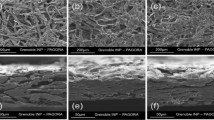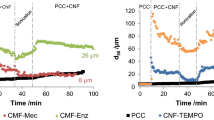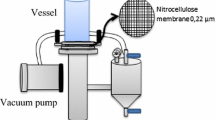Abstract
The use of nanocelluloses as strength-enhancing additives in papermaking is widely known since both cellulose nanofibers (CNF) and nanocrystals (CNC) present similar composition than paper but their exceptional properties in the nanometer scale confers a paper quality enhancement. However, some agglomeration problems in CNF and CNC through hydrogen bonding cause a lower improvement of mechanical properties of paper. Therefore, a better dispersion of both nanocelluloses can maximize their effect on paper properties, thus reducing the needed dose to get the same increment in tensile strength and then reducing material costs. To ease the implementation of these nanocelluloses in the production process of recycled paper, typically used operations of these industries have been used. Among them, those devoted to improve the homogeneous mixture of nanocellulose in the pulp suspension have been assessed. Firstly, pulping conditions were studied, including pulping time, temperature and need for soaking as variables. Secondly, some dispersing agents used in papermaking were considered, studying the effect of different types and doses. The highest tensile strength of paper was achieved by applying long pulping times (60 min), getting increments up to 30% with the use of soaking and polyacrylamide as retention system. However, with the use of a low dose of a dispersing agent (0.003%), tensile index can be still increased up to 20.6% avoiding these long times. This study can be of great interest of those researchers trying to implement the use of nanocelluloses as strength additive in papermaking.






Similar content being viewed by others
References
Ahola S, Myllytie P, Osterberg M, Teerinen T, Laine J (2008) Effect of polymer adsorption on cellulose nanofibril water binding capacity and aggregation. BioResources 3:1315–1328
Balea A, Blanco Á, Monte MC, Merayo N, Negro C (2016a) Effect of bleached eucalyptus and pine cellulose nanofibers on the physico-mechanical properties of cartonboard. BioResources 11:8123–8138
Balea A, Merayo N, Fuente E, Delgado-Aguilar M, Mutje P, Blanco A, Negro C (2016b) Valorization of corn stalk by the production of cellulose nanofibers to improve recycled paper properties. BioResources 11:3416–3431
Brodin FW, Gregersen OW, Syverud K (2014) Cellulose nanofibrils: challenges and possibilities as a paper additive or coating material—a review. Nord Pulp Pap Res J 29:156–166
Campano C, Balea A, Blanco A, Negro C (2016) Enhancement of the fermentation process and properties of bacterial cellulose: a review. Cellulose 23:57–91
Campano C, Miranda R, Merayo N, Negro C, Blanco A (2017) Direct production of cellulose nanocrystals from old newspapers and recycled newsprint. Carbohydr Polym 173:489–496
CEPI (2015). Key statistics. European Pulp and Paper Industry
Chen LH, Wang QQ, Hirth K, Baez C, Agarwal UP, Zhu JY (2015) Tailoring the yield and characteristics of wood cellulose nanocrystals (CNC) using concentrated acid hydrolysis. Cellulose 22:1753–1762
Coccia V, Cotana F, Cavalaglio G, Gelosia M, Petrozzi A (2014) Cellulose nanocrystals obtained from Cynara cardunculus and their application in the paper industry. Sustainability 6:5252–5264
Delgado-Aguilar M, Gonzalez I, Pelach MA, De La Fuente E, Negro C, Mutje P (2015) Improvement of deinked old newspaper/old magazine pulp suspensions by means of nanofibrillated cellulose addition. Cellulose 22:789–802
Fatehi P, Kititerakun R, Ni YH, Xiao HN (2010) Synergy of CMC and modified chitosan on strength properties of cellulosic fiber network. Carbohydr Polym 80:208–214
Fernandes SCM, Freire CSR, Silvestre AJD, Neto CP, Gandini A (2011) Novel materials based on chitosan and cellulose. Polym Int 60:875–882
French AD (2014) Idealized powder diffraction patterns for cellulose polymorphs. Cellulose 21:885–896
Gonzalez I, Boufi S, Pelach MA, Alcala M, Vilaseca F, Mutje P (2012) Nanofibrillated cellulose as paper additive in eucalyptus pulps. BioResources 7:5167–5180
Habibi Y (2014) Key advances in the chemical modification of nanocelluloses. Cellulose 43:1519–1542
Habibi Y, Chanzy H, Vignon MR (2006) TEMPO-mediated surface oxidation of cellulose whiskers. Cellulose 13:679–687
Habibi Y, Lucia LA, Rojas OJ (2010) Cellulose nanocrystals: chemistry, self-assembly, and applications. Chem Rev 110:3479–3500
Heitner C (1993) Light-induced yellowing of wood-containing papers—an evolution of the mechanism. In: Heitner C, Scaiano JC (eds) Photochemistry of lignocellulosic materials, vol 531. ACS symposium series. American Chemical Society, Washington, pp 2–25
Henriksson M, Berglund LA, Isaksson P, Lindstrom T, Nishino T (2008) Cellulose nanopaper structures of high toughness. Biomacromol 9:1579–1585
Hubbe MA (2013) Prospects for maintaining strength of paper and paperboard products while using less forest resources: a review. BioResources 9:1634–1763
Marx-Figini M (1978) Significance of the intrinsic viscosity ratio of unsubstituted and nitrated cellulose in different solvents. Die Angew Makromol Chem 72:161–171
Merayo N, Balea A, de la Fuente E, Blanco Á, Negro C (2017a) Interactions between cellulose nanofibers and retention systems in flocculation of recycled fibers. Cellulose 24:677–692
Merayo N, Balea A, de la Fuente E, Blanco Á, Negro C (2017b) Synergies between cellulose nanofibers and retention additives to improve recycled paper properties and the drainage process. Cellulose 24:2987–3000
Osong SH, Norgren S, Engstrand P (2016) Processing of wood-based microfibrillated cellulose and nanofibrillated cellulose, and applications relating to papermaking: a review. Cellulose 23:93–123
Petroudy SRD, Syverud K, Chinga-Carrasco G, Ghasemain A, Resalati H (2014) Effects of bagasse microfibrillated cellulose and cationic polyacrylamide on key properties of bagasse paper. Carbohydr Polym 99:311–318
Roman M, Winter WT (2004) Effect of sulfate groups from sulfuric acid hydrolysis on the thermal degradation behavior of bacterial cellulose. Biomacromol 5:1671–1677
Saito T, Kimura S, Nishiyama Y, Isogai A (2007) Cellulose nanofibers prepared by TEMPO-mediated oxidation of native cellulose. Biomacromol 8:2485–2491
Salam A, Lucia LA, Jameel H (2013) A novel cellulose nanocrystals-based approach to improve the mechanical properties of recycled paper. ACS Sustain Chem Eng 1:1584–1592
Segal L, Creely JJ, Martin AE, Conrad CM (1959) An empirical method for estimating the degree of crystallinity of native cellulose using the X-ray diffractometer. Text Res J 29:786–794
Suhr M, Klein G, Kourti I, Rodrigo Gonzalo M, Giner Santonja G, Roudier S, Delgado Sancho L (2015) Best available techniques (BAT) reference document for the production of pulp, paper and board. Institute for Prospective Technological Studies, Seville. https://doi.org/10.2791/370629
Sun B, Hou Q, Liu Z, Ni Y (2015) Sodium periodate oxidation of cellulose nanocrystal and its application as a paper wet strength additive. Cellulose 22:1135–1146
Taipale T, Osterberg M, Nykanen A, Ruokolainen J, Laine J (2010) Effect of microfibrillated cellulose and fines on the drainage of kraft pulp suspension and paper strength. Cellulose 17:1005–1020
Tasman JE, Berzins V (1957) The permanganate consumption of pulp materials. Tappi 40:691–704
Acknowledgments
The authors wish to thank the Economy and Competitiveness Ministry of Spain for the support of the project with reference CTQ2013-48090-C2-1-R and the Grant of C. Campano (BES-2014-068177).
Author information
Authors and Affiliations
Corresponding author
Rights and permissions
About this article
Cite this article
Campano, C., Merayo, N., Balea, A. et al. Mechanical and chemical dispersion of nanocelluloses to improve their reinforcing effect on recycled paper. Cellulose 25, 269–280 (2018). https://doi.org/10.1007/s10570-017-1552-y
Received:
Accepted:
Published:
Issue Date:
DOI: https://doi.org/10.1007/s10570-017-1552-y




